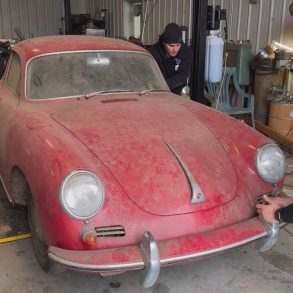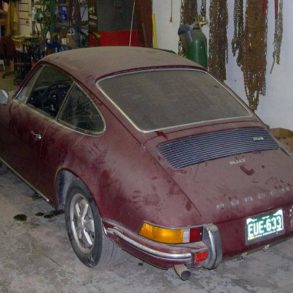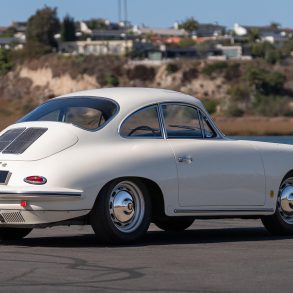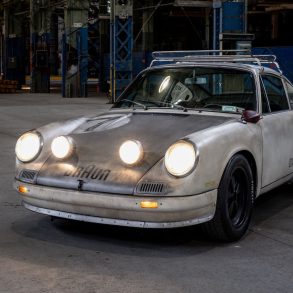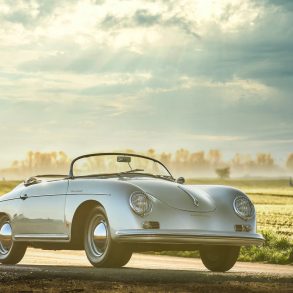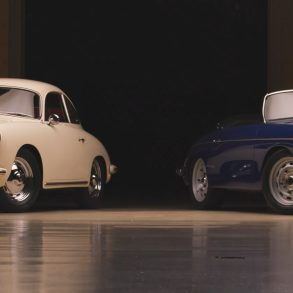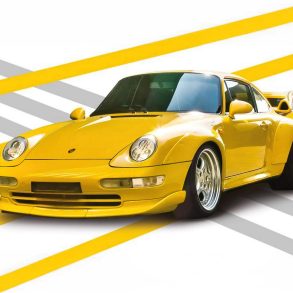Episode Two: The Porsche 901/912 Summary
Welcome to The Audiobahn, the Stuttcars.com podcast focused on all things Porsche. In our first series, we’re exploring the history of venerable 911: its history, origins, achievements, and future.
Audiobahn Episode Two is all about the Porsche 901/912, the car unveiled in 1963 at the Frankfurt auto show (and also the car that would replace the venerable 356).
Read the Podcast Transcript
B: Hey everyone, welcome to the Audiobond. I’m Brayden Clark and this is Chris Carnduff.
We are your Porsche podcast. We take all of the really interesting articles written on stuttcars.com and turn them into these informative, fun, Porsche podcasts.
We’re looking at the history of the 911 in this series, going from the very beginning, until now, to try to understand what makes this car so unique and revolutionary. Last week, if you missed it, we looked at the 356. The very origin. Now we’re going to look at the 901.
C: And the 912.
B: And the 912.
C: I’m going to save my feelings about the 912 until later in the episode.
B: Okay.
C: The 912 isn’t quite a 911, but it is close enough that we just can’t get away without mentioning it. It deserves it’s cup of coffee and it’s really interesting.
B: Sounds like a plan. Are you ready?
C: Well i’m ready are you ready?
B: I’m ready, let’s go.
C: Porsche started designing the replacement for the 356 sometime in 1959 and this largely fell into the lap of Ferdinand Alexander Butzi Porsche. This is the third in the Porsche line for those who are keeping track at home.
By 1961, the first CAD designs or the first clay assisted designs.
B: Such a dumb joke.
C: It’s great! It’s a fantastic joke. It’s also real, it is clay assistant. The first clay models were coming out in 1961 and by 64 the first prototypes were being produced. In 1963, the Frankfurt auto show was the first time the public got a glimpse of the new direction that Porsche was going after the 356.
This was by no means a small task by the way. They were replacing the 356, which they had around since 48, so this is a car that’s existed and was a huge part of their development and design process for so long.
The new platform, the new sandbox to deal with. It had a longer wheelbase than the 356, it had a far more compact and way more efficient suspension design.
B: You were telling me about that earlier.
C: Oh we’re gonna get to it, but oooh it’s good and of course it had a far bigger and far more powerful engine. It had two more cylinders.
The 901 debuted with the 2-liter flat 6 engine, which was putting out about 130 horsepower. Which for those keeping track at home, was about 40 more horsepower than the super 90 engines from the 356.
The topped out 356 engine was putting out 90 horsepower, but this brand new flat 6 is putting out 40 more horsepower than that.
B: It’s a great place to be starting off in.
C: Yeah it’s a massive deal. We’re already we’re dealing with a lighter, better designed car, that has more power.
This is in every way an upgrade from the 356. But it wasn’t just more muscle and call it a day. It wasn’t the whole American idea of oh well here, a new model. We’re going to take out the 350 or the 302 and we’re going to put a 460 engine in.
We’re not trying to just get there, we’re trying to make a holistic vehicle. So this is where the suspension comes in, and it’s so good because they totally redesigned the suspension.
The 356, per wheel, the amount of suspension parts is about the same as the number on the model, 350.
B: Is that for the entire suspension system?
C: No, we’re talking about per wheel. It’s a wild amount of parts and that’s including all your brass bushings, all your fittings. Everything. The 901 suspension and the 911 suspension system was far less complicated, but also way more efficient.
The big changes from the 356 to the the 901 was that the 901 used the McPherson strut design. This is a single A-arm construction and basically what it means is the amount of negative camber that you get is equalized to how much you’re turning so you keep far more contact with the pavement with the wheel.
As opposed to this strictly torsion bar design of the 356’s which were just hard to work on. Whenever you took out the bushings you had to put a brand new one on and you had to fit it manually to the car and there was no rubber to be found.
B: We’re talking significantly simpler and significantly more effective.
C:Way more effective. The 911 was able to enter in corners and leave corners faster than the 356 because of this McPherson strut design, which everybody knows that’s just better in every way.
It’s faster with its engine, it’s faster with the suspension. Everything is just better on the 901. There was a bit of a snag however.
B: Interesting, okay.
C: Peugeot, everybody’s favorite french brand had a bit of a problem with the 901 tag. Peugeot had a monopoly, essentially, on any model number which had a zero in the middle of it and it was three digits long.
They got into Porsche’s face and said “hey you’re not allowed to do that, we have this right”, and Porsche, rather than really putting up too much of a fuss, they just capitulated and they said okay. Out comes the one, out comes the zero, in goes a one.
B: And that’s how we have the 911.
C: That’s it. And so the 911 was finally born. Porsche did have one more problem to solve though with 911. It was expensive. And they needed some way to kind of convince people to still buy Porsches.
The reason why the 911 was so much more expensive was because of technological improvements: more powerful engine, all of these really good reasons why they could charge you more for it and why they ultimately needed to.
Porsche had a really healthy race team, by the way, and something that any everybody pretty well knows about car manufacturers that have a race team, it’s that they sell you cars so that they can afford to race.
So they were charging more money for the 911 and they should have. Economically they needed to find a way to bridge that gap and the way they did this was with a really really cool car called the 912.
This is one of those instances in car history where as a car enthusiast you look at and you get kind of giddy because there’s this weird kind of sub model that just fills this really nice niche and it’s kind of goofy and if you saw somebody with it you’d be really really excited even though somebody else would look at it and they go “oh it’s not a 911”.
You can go but it’s a 912, it’s so much cooler. It really isn’t, but there’s this really cool niche.
B: Just based on its uniqueness.
C: Yeah, you got it. It has a limited run, it goes up until 1969 before it’s phased out entirely because of a whole host of reasons.
For the years that it’s running, it’s filling this great gap of being less expensive than the 911, but still maintaining that kind of 911 status.
So what they did for the 912 is they took the 911 base, the body and the suspension, all of that. But instead of putting the flat 6 engine in it, they put in the super 90 engine.
So it’s the 356 top of the line engine into a 911. Which means it’s slower. A lot slower. In the 901, or the early 911, it was going zero to 60 in eight seconds. It’s depending on which year you’re talking about. Specifically in 64, we’re talking about an 8.3 second, 0 to 60.
The 912 was going 0 to 60 in about 11 seconds, maybe 11 and a half.
B: Substantially slower.
C: However, it’s still a super light nimble, two plus two designed car, with an engine that has more than enough power for it.
So if you can’t afford to go out and get this powerhouse of a 911, that’s cool, come and get this 912.
And it’s still a driver’s car. You’re still going to be able to take your turns like nothing else because it’s got that McPherson strut system. Everything is running the way it should. It’s holding its own. It’s still a 911, just with a smaller four-cylinder engine and I love that so much.
And it runs for this really limited amount of time before Porsche gets kind of their three tiers of power into the 911. They have the 911 T and the 911 E and the 911 S and then the 914 kind of comes in and fills that niche that the 912 had. So the 912 doesn’t make any sense anymore after 1969.
For those few years between the the death of the 356 and the introduction of this whole structure around the 911, the 912 fits this incredible space where it just fills everything in so well and it’s this super cool car and it’s just so weird and awesome and I love it so
much.
And you should too.
B: I do.
C:You’re just smiling away you should be excited.
B:I am excited. Kaitlyn, can you make me look excited in post?
C: It’s this really really great car and it ends in 1969 for all these really good reasons. It’s a really fitting end to a car that filled its niche just so well.
I think the 1960s represents this really incredible time in automotive history just about everywhere you look. For Porsche it represents this whole turnover.
We’re going from the 356 to the 911. We have to go through this whole thing with Peugeot and we’re still really in deep in racing and we’re starting to focus on production cars as well and the 912 and the 911 the 914 are all kind of within this really big beautiful picture of the 1960s as this developing automotive company.
This nice fun fact about the 912 for you as well: 30 miles to the gallon. Which is great for today right? Today’s cars if you got a car that’s getting 30 miles to the gallon to 36 miles to the gallon, oh boy. Really, really great.
Mind you, the 912 also doesn’t have 200 horsepower and it also isn’t carrying 6000 pounds of safety equipment. But you’re getting 30 miles to the gallon in the 1960s. In a small nimbly handling sport coupe. I just love it.
It makes me excited and the 911 is going to get more and more powerful and get way cooler than the 912 is at this point in time and Porsche is going to fill in that gap just underneath the 911 in a whole host of different ways over the decades.
But for the 1960s it’s “here’s a 911 with smaller engine”, and I think that is just – it makes me so happy as an automotive enthusiast.
B: I love that because it’s a beautiful. That whole series the 901 and the 912, obviously the 911, just feels like a really good, beautiful transition period.
Because you have this brand new platform to work on, but now you’ve got a problem where you might be alienating some of your customer base because it’s so much more expensive.
So you still introduce a whole host of people to the new suspension, the better performance, the lighter body, simply by making another model in the 912. Really interesting. Love that.
C: I think it’s genius and so simple. It’s everything you hope for as a car enthusiast.
B: That is our overview of the 901 and 912. Next week, we’re going to be looking into the Porsche 911 T, E and S, what makes the differences between those models, up until 1969.
Speaking of 69, you had an interesting fact for us.
C: Yeah Getty Lee turns 69 today, acclaimed bassist, piano player and singer.
B: I would I would tell you to get through that fact quicker, but there’s no rush.
That was a terrible joke.
Thank you guys for being on this podcast. Thanks Chris for being here and thank you for the amazing team at Stuttcars.com for all the great articles and research. We’ll talk to you next week. Bye.


